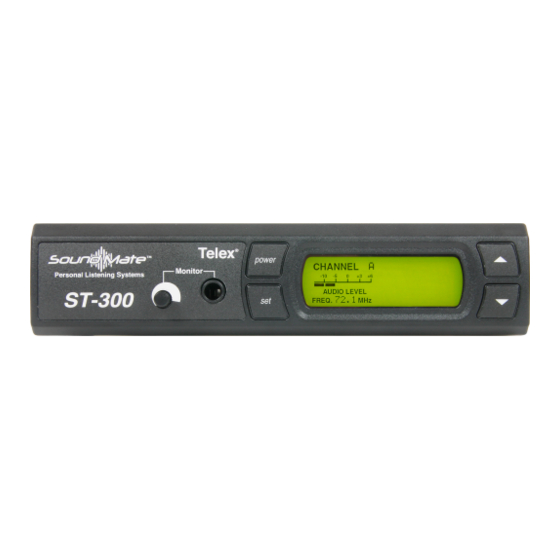Table of Contents
Advertisement
Quick Links
Preliminary Operating Instructions
Telex Model ST-300 Auditory Assistance Transmitter
Carefully unpack your Auditory Assistance Transmitter. If there is any damage or
shortages, please refer to the "Warranty Service Information".
Set-up Instructions:
Power: Power will be received from the supplied "wall cube". Before applying
power, it is suggested that all input cords be plugged in and the antenna be screwed
onto the transmitter. Insert the cord plug into the transmitter before plugging in the
wall cube. The wall cube normally supplied is for 120 V AC, 60 Hz use only.
Transmitter Location: Select a suitable location for the transmitter. Try to keep a
clear, unobstructed path between the transmitter and the receiver. The transmitter
should not be located near metallic objects such as building structures and file
cabinets. Locating the transmitter on top of a file cabinet is OK. Avoid high heat sources
such as radiators .
Antenna: The transmitter uses a special "reverse" RF connector on the model ST-300.
This is intentional and is designed to comply with FCC Part 15 Rules. The antenna
supplied should be the only antenna used with the ST-300. The antenna is designed to
operate in the vertical position.
Audio Input: One or both of the audio input connections can be used at the same time. A
single modulation limiter serves both inputs. If either input is not used, that input should
be "turned off". Unbalanced devices should be plugged into the ¼ in. (quarter inch)
Unbalanced Audio input jack located on the rear panel. Tip is "hot" and the barrel is
ground. Balanced devices should be plugged into the Balanced Audio "XLR" jack
located on the rear panel. Pin 1 is Common (or ground), Pin 2 is audio input, Pin 3 is
audio input. See operating instructions for additional information.
E.D.R. audio: The Telex ST-300 Transmitter is equipped with E.D.R., Enhanced
Dynamic Range (companded) audio. This mode greatly improves the Audio Signal
to Noise Ratio when the ST-400 is used with the Telex Model SR-400 receiver. The
E.D.R. mode must be selected on the transmitter and receiver to be effective. Also,
The E.D.R. Mode must be de-selected if the ST-300 is used with more economical
receivers such as the Telex SR-50 receiver. See Operating Instructions for further
information.
Advertisement
Table of Contents

Summary of Contents for Telex ST-300
- Page 1 Antenna: The transmitter uses a special “reverse” RF connector on the model ST-300. This is intentional and is designed to comply with FCC Part 15 Rules. The antenna supplied should be the only antenna used with the ST-300. The antenna is designed to operate in the vertical position.
- Page 2 Telex ST-300 Transmitter Page 2 Frequency/Channel Considerations: As with any radio device, interference can occur at any time. The frequencies offered are shared with other legitimate users. Check the frequency/channel with the matching receiver to see if any interference is present. If interference is present, choose a different channel.
- Page 3 Telex ST-300 Transmitter Page 3 Operating Instructions:When the Power button is pressed, the Channel, Frequency and existing audio settings are displayed. After 10 seconds (unless another button is pressed) the audio settings are blanked out. After this point, switch functions as follows:...
- Page 4 Telex ST-300 Transmitter Page 4 Power Lock: To lock the power button ON, Press the set and the up and the down buttons at the same time until a small “lock” icon near the channel icon flashs two times. The lock icon will then disappear. Pressing the power button while in lock mode will cause the lock icon to flash.
- Page 5 Please see the separate Warranty Card supplied with this product. APPROVAL INFORMATION: The Telex Model ST-300 is authorized under Federal Communications Commission and Industry Canada Rules . Licensing of the Transmitter, if required, is the users responsibility and licensability depends upon the users classification, and frequency selected.



Need help?
Do you have a question about the ST-300 and is the answer not in the manual?
Questions and answers